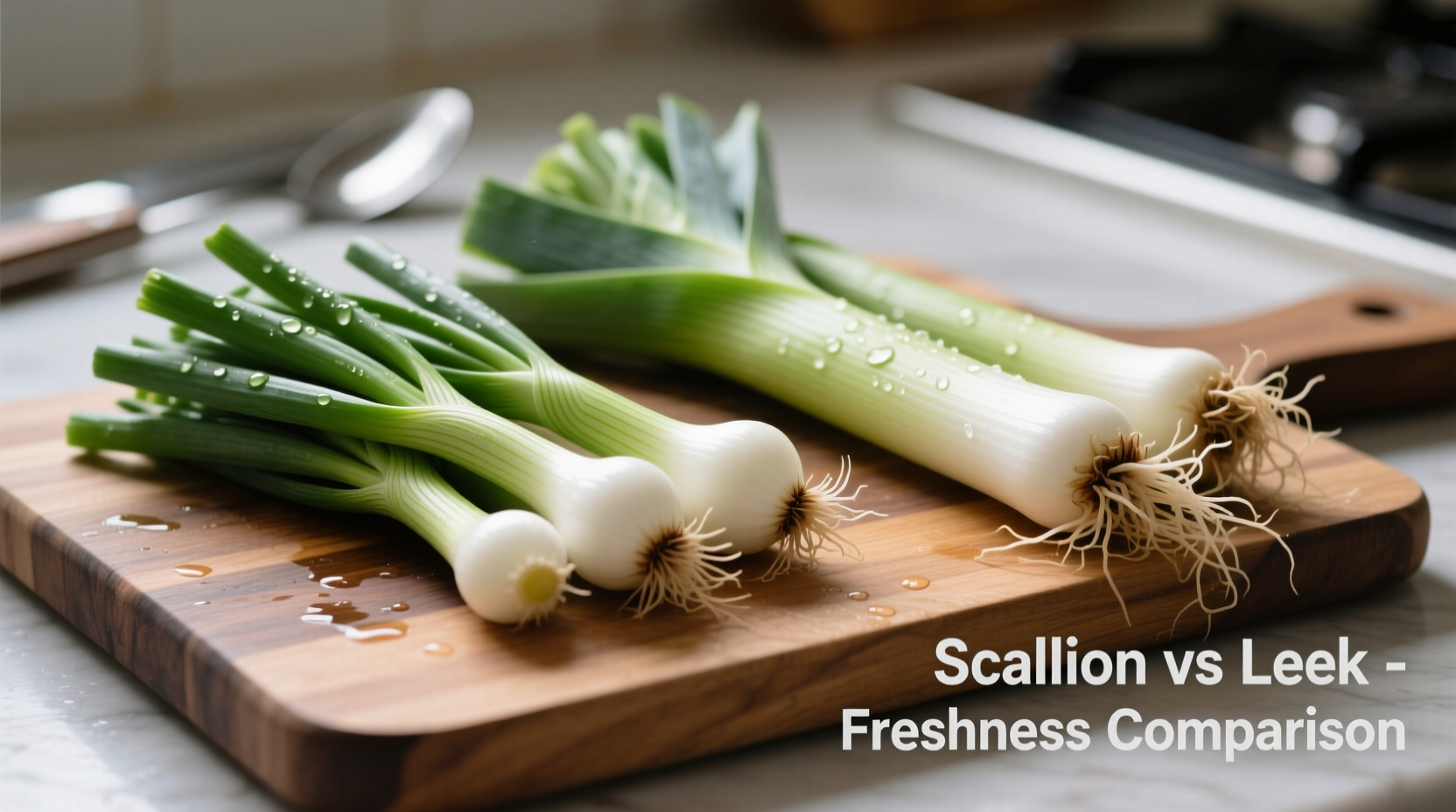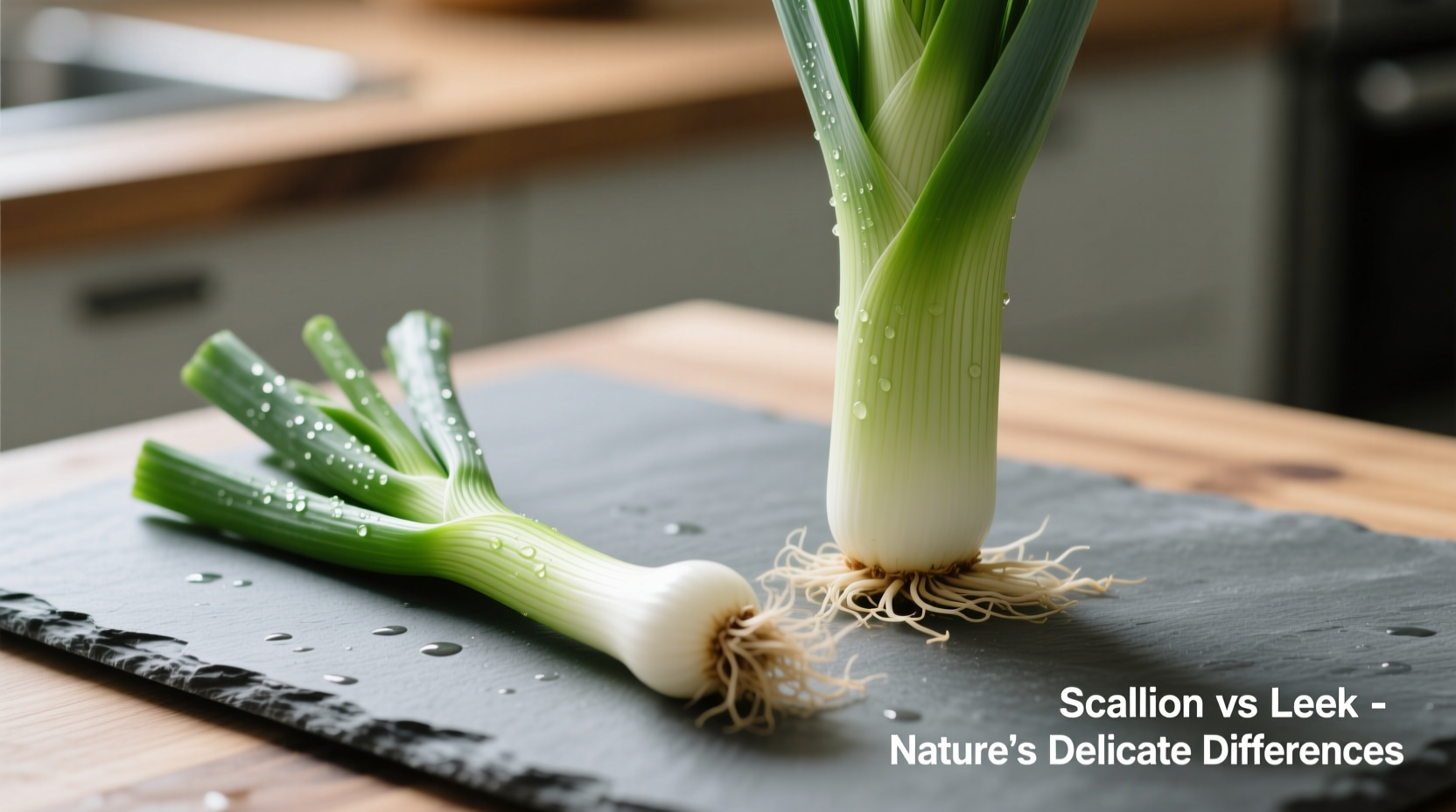Scallions and leeks are both members of the Allium family but differ significantly in size, flavor intensity, and culinary applications. Scallions (also called green onions) feature a slender white base with hollow green stalks and offer a sharp, pungent bite perfect for garnishes. Leeks are larger with flat, broad leaves and a milder, sweeter flavor ideal for slow-cooked dishes. Understanding these differences ensures proper substitution and optimal flavor in your cooking.
Ever stood in the produce aisle confused by the similar-looking allium vegetables? You're not alone. Many home cooks struggle to distinguish between scallions and leeks, often leading to recipe failures when substituting one for the other. As someone who's worked with professional chefs and home cooks for over 15 years, I've seen how this simple confusion can transform a delicious dish into a culinary disappointment.
Spotting the Difference: Visual Identification Guide
At first glance, scallions and leeks might seem like variations of the same vegetable. But understanding their physical characteristics prevents costly kitchen mistakes. Let's break down exactly how to tell them apart:
| Characteristic | Scallion (Green Onion) | Leek |
|---|---|---|
| Size | 6-8 inches long, pencil-thin (¼ inch diameter) | 12-18 inches long, 1-2 inches diameter at bulb |
| White Base | Small, barely formed bulb | Pronounced oval-shaped bulb |
| Green Stalks | Hollow, uniform diameter | Flat, broad leaves that widen significantly |
| Color Transition | Sharp white-to-green transition | Gradual transition from white to light green to dark green |
| Roots | Thin, hair-like roots | Thicker, more substantial roots |
This visual distinction matters because misidentification leads to flavor imbalances. A recipe calling for delicate leeks that gets scallions instead will taste overwhelmingly sharp, while using leeks where scallions are specified creates a dish lacking that bright, fresh bite.

Flavor Profiles: When Sharpness Meets Subtlety
The flavor difference between these alliums explains why professional chefs treat them as distinct ingredients rather than interchangeable options:
- Scallions deliver an immediate, sharp onion punch with noticeable heat. Their flavor remains relatively consistent whether raw or cooked, making them ideal for finishing dishes.
- Leeks offer a much milder, sweeter profile with subtle earthy notes. When cooked slowly, they develop complex caramelized flavors without the harsh bite of raw onions.
According to research published in the Journal of Agricultural and Food Chemistry, scallions contain higher concentrations of allyl sulfides—the compounds responsible for that characteristic onion heat—compared to leeks. This chemical difference explains why substituting one for the other dramatically alters a dish's flavor profile.
Culinary Applications: Knowing When to Use Which
Understanding each vegetable's strengths prevents common cooking mistakes. Here's when to reach for each:
Best Uses for Scallions
- Raw applications: garnishes, salads, salsas
- Quick-cooked dishes: stir-fries, omelets, last-minute additions
- When you need bright, immediate onion flavor
- Asian cuisine where their sharpness complements soy and ginger
Best Uses for Leeks
- Slow-cooked dishes: soups, stews, braises
- When you need subtle onion flavor without overpowering other ingredients
- Creamy preparations: potato leek soup, quiches, gratins
- French and European cuisine where their sweetness enhances sauces
The USDA National Nutrient Database reveals additional differences that affect cooking decisions. Leeks contain more dietary fiber (1.8g per 100g) compared to scallions (2.6g), while scallions provide significantly more vitamin C (18.8mg vs 12mg per 100g). These nutritional variations influence both health considerations and how each vegetable behaves during cooking.
Preparation Techniques: Avoiding Common Mistakes
Proper preparation maximizes flavor and minimizes waste for both vegetables:
Scallion Preparation
- Trim root ends and any wilted green tips
- Rinse thoroughly—dirt often hides between layers
- Use white and light green parts for cooking, dark green for garnish
- Store wrapped in damp paper towel in refrigerator crisper drawer
Leek Preparation
- Cut off root end and dark green tops (save for stock)
- Slice lengthwise to expose layers
- Rinse thoroughly under running water—leeks trap significant dirt between layers
- Soak in cold water to remove remaining grit
- Store unwashed in plastic bag for up to 2 weeks
Many home cooks waste perfectly good parts by discarding the dark green sections of leeks. While too tough to eat directly, these tops make excellent vegetable stock. Simply freeze them until you have enough for a batch of homemade stock.
Substitution Guidance: When It Works and When It Doesn't
While substitutions are sometimes necessary, understanding the limitations prevents culinary disasters:
- Scallions for leeks: Only works in raw applications or as a last resort. Use 3-4 scallions for every medium leek required, but expect significantly sharper flavor.
- Leeks for scallions: Never works in raw applications. In cooked dishes, use only the white and light green parts, but recognize you'll lose that characteristic sharp bite.
- Best compromise: For cooked dishes, combine mild yellow onions with a small amount of scallion greens to approximate leek flavor.
Professional chefs at the Culinary Institute of America emphasize that substitution success depends entirely on the cooking method. In quick sautés, the differences become pronounced, while in long-simmered soups, the distinctions blur significantly.
Nutritional Comparison: Health Benefits Beyond Flavor
Both vegetables offer impressive nutritional profiles with some key differences:
- Scallions provide more vitamin C (18.8mg per 100g) and vitamin K (207mcg), supporting immune function and blood clotting.
- Leeks contain higher levels of manganese (14% DV) and folate (20% DV), important for bone health and cell function.
- Both contain allicin compounds with anti-inflammatory properties, though scallions deliver these benefits more intensely.
The Academy of Nutrition and Dietetics notes that both vegetables contribute to heart health through their sulfur compounds, but their different preparation methods affect bioavailability. Raw scallions preserve more heat-sensitive nutrients, while slow-cooked leeks make certain antioxidants more accessible to the body.
Common Mistakes to Avoid
Based on years of culinary experience, here are the most frequent errors I see:
- Mistake: Using entire leeks without proper cleaning
- Solution: Always slice leeks lengthwise and rinse thoroughly—grit ruins otherwise perfect dishes
- Mistake: Substituting leeks for scallions in salsa or guacamole
- Solution: Stick with scallions for raw applications requiring sharp onion flavor
- Mistake: Discarding dark green leek tops
- Solution: Freeze for vegetable stock—nothing goes to waste
- Mistake: Cooking scallions too long, losing their bright flavor
- Solution: Add scallions during the last 2-3 minutes of cooking
Remember that regional naming conventions add to the confusion. In some parts of the world, "scallion" refers to immature leeks, while in others it means green onions. When following international recipes, always check the description rather than relying solely on the name.
Final Thoughts
Mastering the distinction between scallions and leeks transforms your cooking from hit-or-miss to consistently delicious. These allium cousins serve different purposes in the kitchen—scallions for that bright, sharp finish and leeks for subtle, sweet depth. By understanding their unique characteristics, you'll make better ingredient choices that elevate your dishes from ordinary to extraordinary. Keep this guide handy next time you're at the market, and you'll never second-guess which allium to choose.











 浙公网安备
33010002000092号
浙公网安备
33010002000092号 浙B2-20120091-4
浙B2-20120091-4